+ データを開く
データを開く
- 基本情報
基本情報
| 登録情報 | データベース: PDB / ID: 7n65 | ||||||
|---|---|---|---|---|---|---|---|
| タイトル | Complex structure of HIV superinfection Fab QA013.2 and BG505.SOSIP.664 | ||||||
 要素 要素 |
| ||||||
 キーワード キーワード | VIRAL PROTEIN/IMMUNE SYSTEM / HIV-1 Envelope / superinfection antibody QA013.2 / VIRAL PROTEIN / VIRAL PROTEIN-IMMUNE SYSTEM complex | ||||||
| 機能・相同性 |  機能・相同性情報 機能・相同性情報membrane fusion involved in viral entry into host cell / positive regulation of plasma membrane raft polarization / positive regulation of receptor clustering / host cell endosome membrane / clathrin-dependent endocytosis of virus by host cell / viral protein processing / fusion of virus membrane with host plasma membrane / fusion of virus membrane with host endosome membrane / viral envelope / symbiont entry into host cell ...membrane fusion involved in viral entry into host cell / positive regulation of plasma membrane raft polarization / positive regulation of receptor clustering / host cell endosome membrane / clathrin-dependent endocytosis of virus by host cell / viral protein processing / fusion of virus membrane with host plasma membrane / fusion of virus membrane with host endosome membrane / viral envelope / symbiont entry into host cell / virion attachment to host cell / host cell plasma membrane / virion membrane / structural molecule activity / membrane 類似検索 - 分子機能 | ||||||
| 生物種 |   Human immunodeficiency virus 1 (ヒト免疫不全ウイルス) Human immunodeficiency virus 1 (ヒト免疫不全ウイルス) Homo sapiens (ヒト) Homo sapiens (ヒト) | ||||||
| 手法 | 電子顕微鏡法 / 単粒子再構成法 / クライオ電子顕微鏡法 / 解像度: 4.15 Å | ||||||
 データ登録者 データ登録者 | Mangala Prasad, V. / Shipley, M.M. / Overbaugh, J.M. / Lee, K.K. | ||||||
| 資金援助 |  米国, 1件 米国, 1件
| ||||||
 引用 引用 |  ジャーナル: Elife / 年: 2021 ジャーナル: Elife / 年: 2021タイトル: Functional development of a V3/glycan-specific broadly neutralizing antibody isolated from a case of HIV superinfection. 著者: Mackenzie M Shipley / Vidya Mangala Prasad / Laura E Doepker / Adam Dingens / Duncan K Ralph / Elias Harkins / Amrit Dhar / Dana Arenz / Vrasha Chohan / Haidyn Weight / Kishor Mandaliya / ...著者: Mackenzie M Shipley / Vidya Mangala Prasad / Laura E Doepker / Adam Dingens / Duncan K Ralph / Elias Harkins / Amrit Dhar / Dana Arenz / Vrasha Chohan / Haidyn Weight / Kishor Mandaliya / Jesse D Bloom / Frederick A Matsen / Kelly K Lee / Julie M Overbaugh /   要旨: Stimulating broadly neutralizing antibodies (bnAbs) directly from germline remains a barrier for HIV vaccines. HIV superinfection elicits bnAbs more frequently than single infection, providing clues ...Stimulating broadly neutralizing antibodies (bnAbs) directly from germline remains a barrier for HIV vaccines. HIV superinfection elicits bnAbs more frequently than single infection, providing clues of how to elicit such responses. We used longitudinal antibody sequencing and structural studies to characterize bnAb development from a superinfection case. BnAb QA013.2 bound initial and superinfecting viral Env, despite its probable naive progenitor only recognizing the superinfecting strain, suggesting both viruses influenced this lineage. A 4.15 Å cryo-EM structure of QA013.2 bound to native-like trimer showed recognition of V3 signatures (N301/N332 and GDIR). QA013.2 relies less on CDRH3 and more on framework and CDRH1 for affinity and breadth compared to other V3/glycan-specific bnAbs. Antigenic profiling revealed that viral escape was achieved by changes in the structurally-defined epitope and by mutations in V1. These results highlight shared and novel properties of QA013.2 relative to other V3/glycan-specific bnAbs in the setting of sequential, diverse antigens. | ||||||
| 履歴 |
|
- 構造の表示
構造の表示
| ムービー |
 ムービービューア ムービービューア |
|---|---|
| 構造ビューア | 分子:  Molmil Molmil Jmol/JSmol Jmol/JSmol |
- ダウンロードとリンク
ダウンロードとリンク
- ダウンロード
ダウンロード
| PDBx/mmCIF形式 |  7n65.cif.gz 7n65.cif.gz | 494 KB | 表示 |  PDBx/mmCIF形式 PDBx/mmCIF形式 |
|---|---|---|---|---|
| PDB形式 |  pdb7n65.ent.gz pdb7n65.ent.gz | 表示 |  PDB形式 PDB形式 | |
| PDBx/mmJSON形式 |  7n65.json.gz 7n65.json.gz | ツリー表示 |  PDBx/mmJSON形式 PDBx/mmJSON形式 | |
| その他 |  その他のダウンロード その他のダウンロード |
-検証レポート
| 文書・要旨 |  7n65_validation.pdf.gz 7n65_validation.pdf.gz | 4.4 MB | 表示 |  wwPDB検証レポート wwPDB検証レポート |
|---|---|---|---|---|
| 文書・詳細版 |  7n65_full_validation.pdf.gz 7n65_full_validation.pdf.gz | 4.5 MB | 表示 | |
| XML形式データ |  7n65_validation.xml.gz 7n65_validation.xml.gz | 81 KB | 表示 | |
| CIF形式データ |  7n65_validation.cif.gz 7n65_validation.cif.gz | 121.7 KB | 表示 | |
| アーカイブディレクトリ |  https://data.pdbj.org/pub/pdb/validation_reports/n6/7n65 https://data.pdbj.org/pub/pdb/validation_reports/n6/7n65 ftp://data.pdbj.org/pub/pdb/validation_reports/n6/7n65 ftp://data.pdbj.org/pub/pdb/validation_reports/n6/7n65 | HTTPS FTP |
-関連構造データ
- リンク
リンク
- 集合体
集合体
| 登録構造単位 | 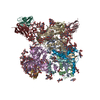
|
|---|---|
| 1 |
|
- 要素
要素
-Envelope glycoprotein ... , 2種, 6分子 AEIBFJ
| #1: タンパク質 | 分子量: 56846.613 Da / 分子数: 3 / 変異: T332N / 由来タイプ: 組換発現 由来: (組換発現)   Human immunodeficiency virus 1 (ヒト免疫不全ウイルス) Human immunodeficiency virus 1 (ヒト免疫不全ウイルス)株: BG505 / 遺伝子: env / 細胞株 (発現宿主): Expi293F / 発現宿主:  Homo sapiens (ヒト) / 参照: UniProt: A0A6H1VCM1 Homo sapiens (ヒト) / 参照: UniProt: A0A6H1VCM1#2: タンパク質 | 分子量: 18245.830 Da / 分子数: 3 / 由来タイプ: 組換発現 由来: (組換発現)   Human immunodeficiency virus 1 (ヒト免疫不全ウイルス) Human immunodeficiency virus 1 (ヒト免疫不全ウイルス)株: BG505 / 遺伝子: env / 細胞株 (発現宿主): Expi 293F / 発現宿主:  Homo sapiens (ヒト) / 参照: UniProt: Q2N0S7 Homo sapiens (ヒト) / 参照: UniProt: Q2N0S7 |
|---|
-抗体 , 2種, 6分子 CGKDHL
| #3: 抗体 | 分子量: 14384.085 Da / 分子数: 3 / 由来タイプ: 組換発現 / 由来: (組換発現)  Homo sapiens (ヒト) / 細胞株: Peripheral blood mononuclear cell / 細胞株 (発現宿主): HEK 293F / 発現宿主: Homo sapiens (ヒト) / 細胞株: Peripheral blood mononuclear cell / 細胞株 (発現宿主): HEK 293F / 発現宿主:  Homo sapiens (ヒト) Homo sapiens (ヒト)#4: 抗体 | 分子量: 11189.263 Da / 分子数: 3 / 由来タイプ: 組換発現 / 由来: (組換発現)  Homo sapiens (ヒト) / 細胞株: Peripheral blood mononuclear cell / 細胞株 (発現宿主): HEK 293F / 発現宿主: Homo sapiens (ヒト) / 細胞株: Peripheral blood mononuclear cell / 細胞株 (発現宿主): HEK 293F / 発現宿主:  Homo sapiens (ヒト) Homo sapiens (ヒト) |
|---|
-糖 , 8種, 63分子 
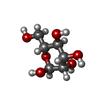

| #5: 多糖 | beta-D-mannopyranose-(1-4)-2-acetamido-2-deoxy-beta-D-glucopyranose-(1-4)-2-acetamido-2-deoxy-beta- ...beta-D-mannopyranose-(1-4)-2-acetamido-2-deoxy-beta-D-glucopyranose-(1-4)-2-acetamido-2-deoxy-beta-D-glucopyranose #6: 多糖 | 2-acetamido-2-deoxy-beta-D-glucopyranose-(1-4)-2-acetamido-2-deoxy-beta-D-glucopyranose #7: 多糖 | #8: 多糖 | #9: 多糖 | #10: 多糖 | #11: 糖 | ChemComp-NAG / #12: 糖 | |
|---|
-詳細
| 研究の焦点であるリガンドがあるか | N |
|---|---|
| Has protein modification | Y |
-実験情報
-実験
| 実験 | 手法: 電子顕微鏡法 |
|---|---|
| EM実験 | 試料の集合状態: PARTICLE / 3次元再構成法: 単粒子再構成法 |
- 試料調製
試料調製
| 構成要素 | 名称: Complex of HIV-1 envelope protein with super-infection Fab QA013.2 タイプ: COMPLEX / Entity ID: #1-#4 / 由来: RECOMBINANT | |||||||||||||||
|---|---|---|---|---|---|---|---|---|---|---|---|---|---|---|---|---|
| 分子量 | 値: 0.5 MDa / 実験値: NO | |||||||||||||||
| 由来(天然) |
| |||||||||||||||
| 由来(組換発現) | 生物種:  Homo sapiens (ヒト) / 細胞: 293F Homo sapiens (ヒト) / 細胞: 293F | |||||||||||||||
| 緩衝液 | pH: 7.4 / 詳細: 1X PBS at pH 7.4, made fresh. | |||||||||||||||
| 緩衝液成分 | 名称: Phosphate buffer saline | |||||||||||||||
| 試料 | 濃度: 0.05 mg/ml / 包埋: NO / シャドウイング: NO / 染色: NO / 凍結: YES / 詳細: Monodisperse sample in PBS | |||||||||||||||
| 試料支持 | グリッドの材料: COPPER / グリッドのサイズ: 400 divisions/in. グリッドのタイプ: PELCO Ultrathin Carbon with Lacey Carbon | |||||||||||||||
| 急速凍結 | 装置: FEI VITROBOT MARK IV / 凍結剤: ETHANE / 湿度: 100 % / 凍結前の試料温度: 277 K / 詳細: 3ul sample volume, blotted for 3-4 seconds |
- 電子顕微鏡撮影
電子顕微鏡撮影
| 実験機器 |  モデル: Titan Krios / 画像提供: FEI Company |
|---|---|
| 顕微鏡 | モデル: FEI TITAN KRIOS / 詳細: Preliminary grid screening was performed manually |
| 電子銃 | 電子線源:  FIELD EMISSION GUN / 加速電圧: 300 kV / 照射モード: FLOOD BEAM FIELD EMISSION GUN / 加速電圧: 300 kV / 照射モード: FLOOD BEAM |
| 電子レンズ | モード: BRIGHT FIELD / 倍率(公称値): 110000 X / 最大 デフォーカス(公称値): 3500 nm / 最小 デフォーカス(公称値): 1700 nm / Cs: 2.7 mm / C2レンズ絞り径: 50 µm / アライメント法: COMA FREE |
| 試料ホルダ | 凍結剤: NITROGEN 試料ホルダーモデル: FEI TITAN KRIOS AUTOGRID HOLDER |
| 撮影 | 平均露光時間: 10 sec. / 電子線照射量: 44 e/Å2 / 検出モード: COUNTING フィルム・検出器のモデル: GATAN K2 SUMMIT (4k x 4k) 実像数: 6475 |
| 画像スキャン | 動画フレーム数/画像: 50 |
- 解析
解析
| ソフトウェア | 名称: PHENIX / バージョン: 1.17.1_3660: / 分類: 精密化 | ||||||||||||||||||||||||||||
|---|---|---|---|---|---|---|---|---|---|---|---|---|---|---|---|---|---|---|---|---|---|---|---|---|---|---|---|---|---|
| EMソフトウェア |
| ||||||||||||||||||||||||||||
| CTF補正 | タイプ: PHASE FLIPPING AND AMPLITUDE CORRECTION | ||||||||||||||||||||||||||||
| 粒子像の選択 | 選択した粒子像数: 1082742 / 詳細: LOG picker | ||||||||||||||||||||||||||||
| 対称性 | 点対称性: C3 (3回回転対称) | ||||||||||||||||||||||||||||
| 3次元再構成 | 解像度: 4.15 Å / 解像度の算出法: FSC 0.143 CUT-OFF / 粒子像の数: 113470 / アルゴリズム: FOURIER SPACE / 対称性のタイプ: POINT | ||||||||||||||||||||||||||||
| 原子モデル構築 | プロトコル: RIGID BODY FIT 詳細: Rigid body fitting in Chimera, followed by real space refinement in Phenix using reference model restraints | ||||||||||||||||||||||||||||
| 原子モデル構築 | PDB-ID: 5ACO Accession code: 5ACO / Source name: PDB / タイプ: experimental model | ||||||||||||||||||||||||||||
| 精密化 | 交差検証法: NONE 立体化学のターゲット値: GeoStd + Monomer Library + CDL v1.2 | ||||||||||||||||||||||||||||
| 原子変位パラメータ | Biso mean: 124.29 Å2 | ||||||||||||||||||||||||||||
| 拘束条件 |
|
 ムービー
ムービー コントローラー
コントローラー




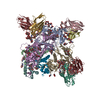
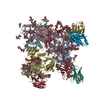
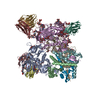

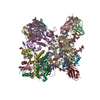
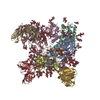
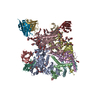

 PDBj
PDBj










